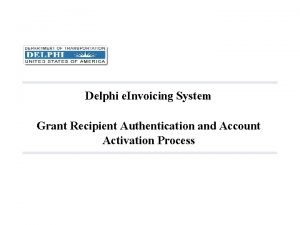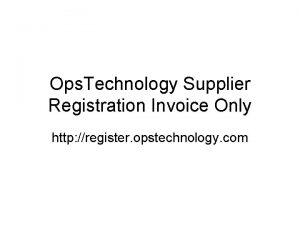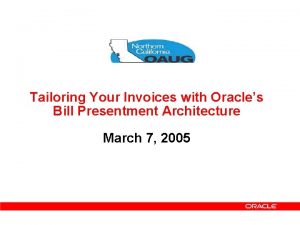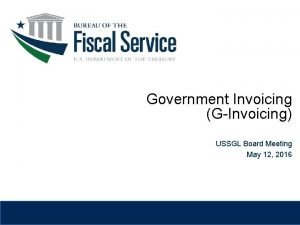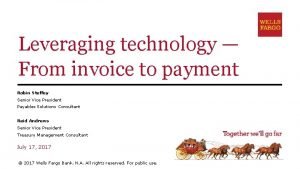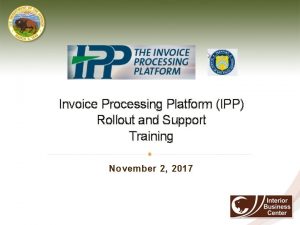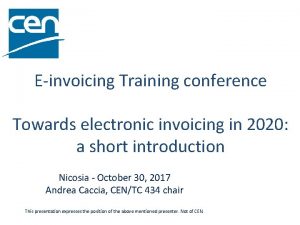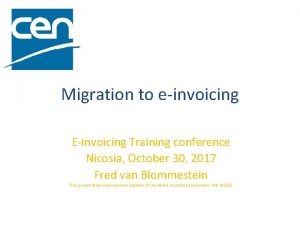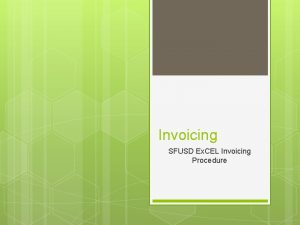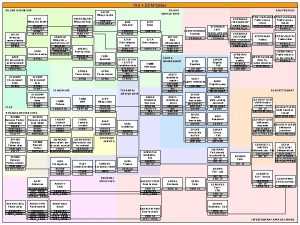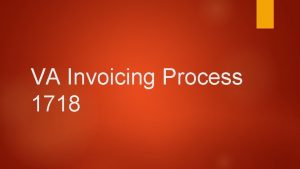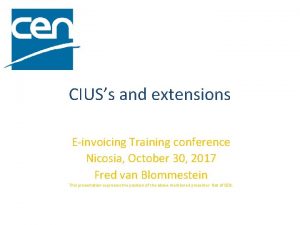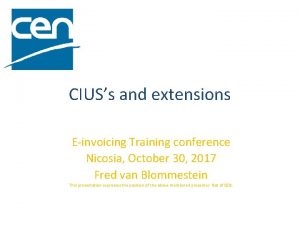Einvoicing Training conference Towards electronic invoicing in 2020










- Slides: 10

E-invoicing Training conference Towards electronic invoicing in 2020: a short introduction Nicosia - October 30, 2017 Andrea Caccia, CEN/TC 434 chair This presentation expresses the position of the above mentioned presenter. Not of CEN.

e. Invoicing in EU: some background § EC Communication COM(2010) 712 final 2010. 12. 02: “Reaping the benefits of electronic invoicing for Europe” – EUR 240 billions savings in 6 years – e-invoicing predominant method by 2020 in EU § The European Parliament called for making einvoicing compulsory in public procurement by 2016 in a resolution adopted in April 2012

Some background information Core Invoice § The European Multi-Stakeholder Forum on electronic Invoicing (EMSFEI) unanimously adopted on Oct 2013 a "Recommendation on the use of a Semantic Data Model to support Interoperability for Electronic Invoicing" § Adoption of Directive 2014/55/EU on electronic invoicing in public procurement Sector Section Common Section Legal Section Country Specific Section

Goals of Directive 2014/55/EU § Reducing complexity, legal uncertainty and additional operating costs for economic operators when using e-invoices across Member States § Promoting the uptake of e-invoicing in public procurement and in the private sector in order to generate significant benefits for Member States and economic operators § Complementing the efforts for the uptake of eprocurement as reflected in Directives 2014/24/EU and 2014/25/EU

Why this European Standard? § Directive 2014/55/EU (Art. 3) requires the Commission to ask the relevant European standardization Organization: • • to draft a European standard (EN) for the semantic data model of the core elements of an electronic invoice; to provide a list with a limited number of syntaxes complying with the European Standard, the appropriate syntax bindings and guidelines on transmission interoperability. § Requires also that the standard shall be tested as for its practical application for an end user

CEN/TC 434 on Electronic Invoicing § The Directive imposed a short time frame: CEN/TC 434 was established already in September 2014 before the official request § The directive included requirements for the European standard: § § § § Technologically neutral Compatible with relevant international standards Consistent with personal data protection requirements Consistent with the VAT Directive (2006/112/EC) Allowing practical, user-friendly, flexible, cost-efficient systems Considering SMEs and sub-central contracting authorities/entities needs Suitable for commercial transactions between enterprises § 10/12/2014 – The Commission issued the official standardisation request with all the details to finalize the TC workplan

Deliverables from CEN/TC 434 • All documents were unanimously approved and are published by CEN (i. e. available to the National Standardization Organizations) • Toolset for Directive 2014/55/EU implementation Reference Topic (not official title) EN 16931 -1 European Standard for the semantic data model of the core elements of an electronic invoice i. e. the content of the invoice valid in Europe TS 16931 -2 A Technical Specification giving a short list of internationally used syntaxes (UBL & CII) that comply with the EN and that public administrations shall support TS 16931 -3 -1 … A set of 4 technical specifications for syntax binding methodology and 3 16931 -3 -4 syntax bindings with the EN for UBL, CII and EDIFACT TR 16931 -4 Transmission guideline TR 16931 -5 EN extension methodology TR 16931 -6 Test results

Directive implementation requirements • EN and short list of syntaxes (parts 1 and 2) • Testing practical application for an end user (practicality, user -friendliness and possible implementation costs) – CEN/TR 16931 -6 (TC 434) – Study on the practical application and implementation of the European e-Invoicing standard (PWC) • Report from the Commission to the European Parliament and the Council on the assessment of the EN (Oct 11, 2017) • Commission Implementing Decision (EU) 2017/1860 of 16 October 2017 (published in OJEU on Oct 17, 2017)

Decision 2017/1860

Questions?

